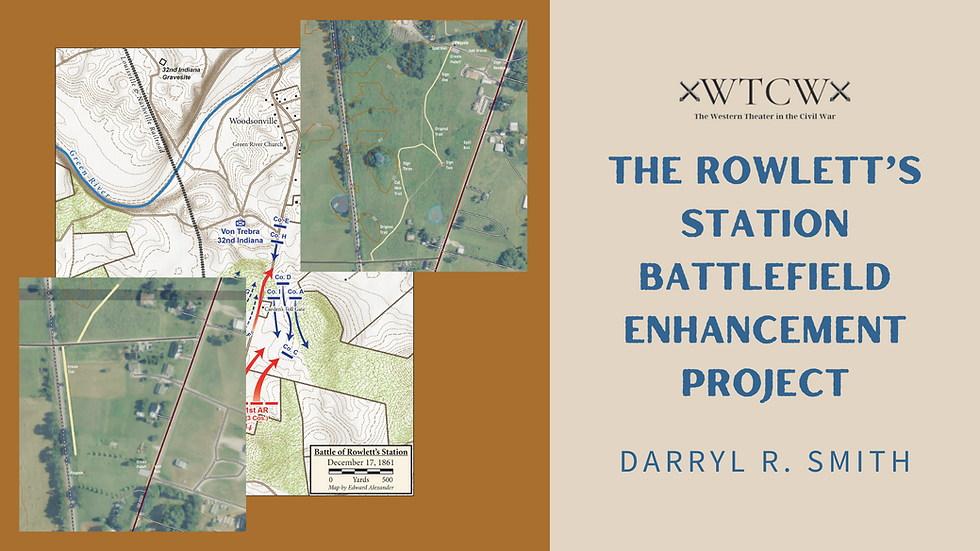West Pointers at Wilson's Creek
- Darryl R. Smith
- Aug 9, 2020
- 2 min read
Updated: Oct 29, 2020
The Battle of Wilson's Creek has long been forgotten by most who study the war, and overshadowed by events in the east. Even though I reside in Ohio Wilson's Creek is a long day's drive (8.5 hours), and I cannot imagine those from further east planning a trip there without an overnight stop or a flight. Therefore, it is in some ways "lost" in the greater scope of the National Park Service's Civil War battlefields. While it shares many of the hallmarks of First Bull Run (inexperienced troops, Federals in gray uniforms), it has its own stories (Sigel's Germans, the death of Lyon, the hard fighting 3rd Louisiana).

Being that Wilson's Creek is a later generation national battlefield within the National Park Service, it does not have the iconography that a Shiloh or Chickamauga contains. Monuments are not only testimonies left by the veterans but they serve as points of interest to tourists. While Wilson's Creek is near a fairly large community (Springfield) one still has to make a bit of an effort to make a visit, especially from those living east of the Mississippi River, even though the park itself is a fine example of what a pristine battlefield looks like and should be on your list of must see battlefields. Without the massive monuments dotting the landscape, the battlefield retains its 1861 appearance. Hence, it is worth the time and effort to visit.
A compelling place to study Wilson's Creek from a different tack is to look at the men from West Point who served in various capacities during the battle. In 1991 John K. Hulston published a small booklet on the West Point influence on the battle at Wilson's Creek. Those who do not have a deep knowledge of the battle may be surprised by who served there.
Eugene A. Carr (1850/19) - Captain, 4th Cavalry. Medal of Honor for Pea Ridge.
Joseph Conrad (1857/32) - First Lieutenant, 2nd Infantry.
John DuBois (1855/10) - First Lieutenant, 3rd Cavalry.
Charles Farrand (1857/36) - First Lieutenant, 1st Infantry.
Charles Champion Gilbert (1846/21) - Captain, 1st Infantry.
Gordon Granger (1845/35) - Captain, 3rd Cavalry.
Louis Hebert (1845/3) - Brevet Second Lieutenant, Corps of Engineers. Colonel, 3rd Louisiana Infantry Regiment.
Daniel Huston (1848/35) - Captain, 1st Infantry.
Nathaniel Lyon (1841/11) - Brigadier General, U. S. Volunteers. Army of the West commander. Killed at Wilson's Creek.
James P. Major (1856/23) - Second Lieutenant, 2nd Cavalry. Lieutenant Colonel, Missouri State Guard cavalry battalion.
James McIntosh (1849/43) - Captain, 1st Cavalry. Colonel, 2nd Arkansas Mounted Regiment. Killed at Pea Ridge.
Nicholas Bartlett Pearce (1850/26) - First Lieutenant, 7th Infantry. Brigadier General.
Joseph B. Plummer (1841/22) - Captain, 1st Infantry. Wounded at Wilson's Creek.
John M. Schofield (1853/7) - Captain, 1st Artillery. Chief of Staff. Medal of Honor for Wilson's Creek.
George Sokalski (1861/40) - Second Lieutenant, 2nd Dragoons.
Frederick Steele (1843/30) - Major, 11th Infantry.
Samuel D. Sturgis (1846/32) - Major, 4th Cavalry. 1st Brigade commander.
James Totten (1841/25) - Captain, 2nd Artillery.
Ranks shown are the United States Army ranks at the time of the battle or at resignation. Units shown are last assigned unit in the United States Army.
Information gleaned from John K. Hulston's West Point & Wilson's Creek.






Comments